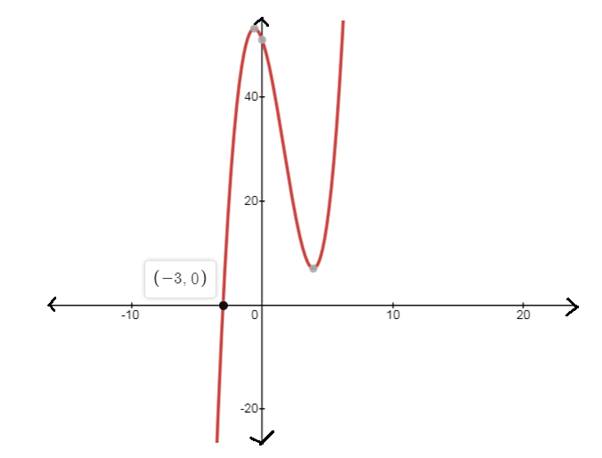
Concept explainers
(a)
To find : all the zeros of function
(a)
Answer to Problem 97CR
Explanation of Solution
Given information :
Concept used:
Zeros of polynomial: -
It is defined by as any real value of
Rational root theorem:
If the polynomial
Calculation:
Since, all coefficients are integers.
So, apply rational zeros theorem
The constant term is 51 and factor of 51 is
If
Check
The quotient is
Check
The quotient is
Check
The quotient is
Since the remainder is
So, the zeros of function
(b)
To find : linear factor of
(b)
Answer to Problem 97CR
Explanation of Solution
Given information :
Concept used:
Zeros of polynomial: -
It is defined by as any real value of
Rational root theorem:
If the polynomial
Calculation:
Since, all coefficients are integers.
So, apply rational zeros theorem
The constant term is 51 and factor of 51 is
If
Check
The quotient is
Since the remainder is
(c)
To find : x-intercepts using the factorization of
(c)
Answer to Problem 97CR
Explanation of Solution
Given information :
Concept used:
Zeros of polynomial: -
It is defined by as any real value of
Rational root theorem:
If the polynomial
Calculation:
Since, all coefficients are integers.
So, apply rational zeros theorem
The constant term is 51 and factor of 51 is
If
Check
The quotient is
Since the remainder is
Graph:

Chapter 2 Solutions
EP PRECALC.GRAPHING APPR.-WEBASSIGN-1YR
- Find the accumulated amount A, if the principal P is invested at an interest rate of r per year for t years. (Round your answer to the nearest cent.) P = $3800, r = 4%, t = 10, compounded semiannually A = $ 5645.60 × Need Help? Read It SUBMIT ANSWER [3.33/6.66 Points] DETAILS MY NOTES REVIOUS ANSWERS ASK YOUR TEACHER TANAPCALC10 5.3.001.EP. PRACTICE ANOTHER Consider the following where the principal P is invested at an interest rate of r per year for t years. P = $3,100, r = 4%, t = 10, compounded semiannually Determine m, the number of conversion periods per year. 2 Find the accumulated amount A (in dollars). (Round your answer to the nearest cent.) A = $ 4604.44arrow_forwardForce with 800 N and 400 N are acting on a machine part at 30° and 60°, respectively with a positive x axis, Draw the diagram representing this situationarrow_forwardI forgot to mention to you to solve question 1 and 2. Can you solve it using all data that given in the pict i given and can you teach me about that.arrow_forward
 Calculus: Early TranscendentalsCalculusISBN:9781285741550Author:James StewartPublisher:Cengage Learning
Calculus: Early TranscendentalsCalculusISBN:9781285741550Author:James StewartPublisher:Cengage Learning Thomas' Calculus (14th Edition)CalculusISBN:9780134438986Author:Joel R. Hass, Christopher E. Heil, Maurice D. WeirPublisher:PEARSON
Thomas' Calculus (14th Edition)CalculusISBN:9780134438986Author:Joel R. Hass, Christopher E. Heil, Maurice D. WeirPublisher:PEARSON Calculus: Early Transcendentals (3rd Edition)CalculusISBN:9780134763644Author:William L. Briggs, Lyle Cochran, Bernard Gillett, Eric SchulzPublisher:PEARSON
Calculus: Early Transcendentals (3rd Edition)CalculusISBN:9780134763644Author:William L. Briggs, Lyle Cochran, Bernard Gillett, Eric SchulzPublisher:PEARSON Calculus: Early TranscendentalsCalculusISBN:9781319050740Author:Jon Rogawski, Colin Adams, Robert FranzosaPublisher:W. H. Freeman
Calculus: Early TranscendentalsCalculusISBN:9781319050740Author:Jon Rogawski, Colin Adams, Robert FranzosaPublisher:W. H. Freeman
 Calculus: Early Transcendental FunctionsCalculusISBN:9781337552516Author:Ron Larson, Bruce H. EdwardsPublisher:Cengage Learning
Calculus: Early Transcendental FunctionsCalculusISBN:9781337552516Author:Ron Larson, Bruce H. EdwardsPublisher:Cengage Learning





